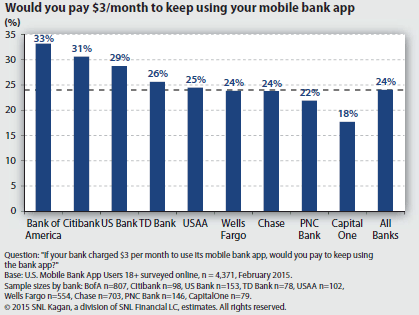Banks and credit unions may be overlooking an easy opportunity to generate additional revenue: Charging customers/members for using the FI’s mobile banking app.
SNL Financial asked nearly 4,400 US-based smartphone banking app consumers “If your bank charged $3 a month to use its mobile bank app, would you pay to keep using the bank app?” One in four respondents said they would.
One of the more interesting cuts on this is how many consumers would be willing to pay by bank. A third of Bank of America mobile banking customers said they would pay to keep using the app, in contrast to just 18% of Capital One’s mobile banking customers.

I was pleased to see that my fellow New Englanders were the least likely (across the regions of the US) to be willing to pay to use a silly little mobile banking app.

But that just might mean that my fellow New Englanders and I are just old fogeys, since Boomers and Seniors are less likely to be willing to pay. Interestingly, a higher percentage of Older Gen Yers (26-35) express a willingness to pay than Younger Gen Yers (18-25) which reinforces my belief that the financial needs of Gen Yers are not uniform across the generation.

***
My take: The best question to ask here is not “can banks charge for mobile banking?” but “should banks charge for mobile banking?”
In the context of the current product/pricing structure in the industry, the answer to the better question is NO.
One of the biggest issues facing banking is the misalignment between cost and value. That is, what consumers pay to have a checking is not aligned with the value they receive from the product. Please don’t try to tell me that consumers think it’s really worth it to them to spend $30 to be able to overdraw on their account, each time they do it. Don’t tell me consumers really get value from paying a monthly fee because they fell under the account minimum. Maybe in an emergency they’re OK paying that ATM fee, but paying that fee doesn’t deliver the value that paying for an Angry Birds mobile apps gives them.
Slapping yet another fee on top of the current pricing structure of checking accounts contributed to the lack of trust and ill will that many consumers have towards banks in the first place.

Navigating Credit Card Issuing in an Uncertain Economic Environment
Build a modern credit card strategy that balances profitability and risk, adopts the latest technology and delivers the customization that cardholders demand.
Read More about Navigating Credit Card Issuing in an Uncertain Economic Environment

Are You Ready for a Digital Transformation?
Unlock the potential of your financial institution's digital future with Arriba Advisors. Chart a course for growth, value and superior customer experiences.
What I’m struggling to understand, though, is why did SNL conduct this research in the first place? Did they set out to prove to banks that a significant percentage of consumers would be willing to pay for mobile banking, and that, therefore, banks should go ahead and charge $3 a month for it in order to increase revenue?
If that were the case, then maybe they should have asked “How likely are you to find another bank to bank with if your current bank charged you $3 a month to use its mobile banking app?”
A good use of the SNL findings is at the individual bank level. If I worked at Capital One, I’d be asking “Why aren’t our customers as likely as BofA’s customers to be willing to pay to continue to use the mobile banking app?”
The answer could be explained by demographics or geography. But I’d bet the better answer is the quality of the mobile banking app.
In other words, maybe the best use of the survey results is not to make pricing decisions, but as a proxy for mobile banking app quality.
One last thought: If anyone from my bank reads this, please don’t charge me $3 a month to use your mobile banking app. I will find a way to extract revenge on you for doing so.







